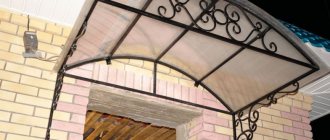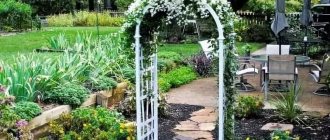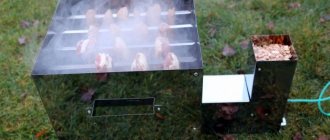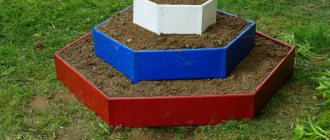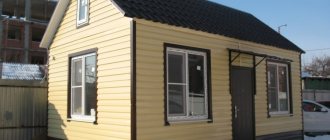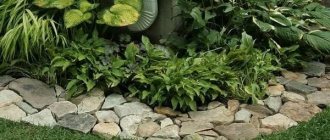Those times when the entire free plot of land near the house was occupied by beds are a thing of the past. Nowadays, owners of cottages and dachas are trying to decorate their local area in an original way. Installing a front garden in front of the house is the most profitable solution.
Brief overview of the article
- Conditions for creating front gardens
- Planning and design of the front garden
- Plant selection
- Front garden decoration
- Decorative elements
- Color selection
- container garden
- Choosing a style
- Pond near the house
- Materials for the pond
- Design of small front gardens
- Wrought iron fencing for front gardens
- Alpine slide near the house
- Setting up a rock garden in a small area
- Photos of front gardens
Conditions for creating front gardens
If you want to make a beautiful front garden, the first thing you need to do is draw up a plan according to which all future work will be carried out. There are several factors to consider such as:
The area of the plot is one of the main design criteria. It will be impossible to create certain compositions in a small area.
Time costs. Ornamental plants require a lot of time to care for. If you are limited in time, it is better to choose plants that are unpretentious.
Material investments. It should be borne in mind that all planting material, as well as the plants themselves, are not cheap, as are all decorative elements.
Seasonality. It is necessary to choose plants that will decorate the garden not only in summer, but also in winter.
How to make a stone flowerbed
Creating a stone flower bed begins with markings. If the flower garden has a simple shape (rectangle, square), the layout can be made directly on the soil, marking the boundaries with a strip of sand or twine tied to pegs. A more complex configuration (for example, a multi-level flowerbed with several tiers) is first drawn on a sheet of paper and then transferred to the ground on a larger scale.
Preparing the Stones
The biggest attraction of the stone flower bed is the largest rock fragments. Free-standing elements must be stable enough so as not to pose a danger to the person caring for the flower garden. When a stone does not have a flat side and can turn over, its shape is corrected using impact tools (hammer, perforator).
If there is plaque, moss residue, mold or other dirt on the surface of the stone, it should first be cleaned mechanically (trowel, brush), and if this does not help, use chemicals. To do this, you can use alkaline pastes or acidic compounds (hydrochloric acid, phosphoric acid, acetic acid).
Important. Treatment of stones with chemicals is carried out away from the flower bed so that the composition does not penetrate into the soil. After cleaning, the surface of the boulders is washed with a strong stream of water.
Laying stones
First, the top layer of soil around the perimeter of the flowerbed is removed, and the earth is well compacted. The width of the groove depends on the width of the parapet, and the depth on its height: the more massive the fence, the wider and deeper the “pit” is dug. The depression is filled halfway with sand, and stones are laid on it in several rows. During installation, each boulder should be carefully selected so that it has the largest possible area of contact with other elements. If the wall is quite high, the stones are fastened together with cement mortar.
Two ways to put stones on the solution:
- All seams and voids between the stones, both on the front and on the inside of the flowerbed, are filled with mortar. The masonry turns out to be strong, but the mortar seam is visible in it;
- Only the internal voids are filled with the solution; the front part of the parapet is left as is. The masonry looks more natural, but water gets into the cracks, and when it freezes, the adhesion strength of the mortar to the stone decreases.
Advice. From constant contact with the ground, stones get dirty and don’t look very attractive. You can prevent contamination by treating them with a hydrophobic impregnation, for example, Remmers Funcosi SL. In addition to protecting against dirt, the product will emphasize the texture of the material.
Example of work made from wild stone:
Plant selection
When choosing plants, you should be guided by the following methods:
- Rules of care.
- Compatibility of plants with each other.
- Flowering period.
- Appearance in different seasons.
- Frost resistance.
- Lifetime of plants.
- The style in which the garden is designed.
Front garden decoration
The following elements are usually used in front garden design:
Lawn. Suitable for any style, fits even into a small space. But it requires labor to create and maintain.
Flower beds. It is better not to overload the garden with them. One large flower bed or mixborder will look most impressive.
Perennial plants. It is advisable to plant at least one tree or bush, even in a small space.
Garden. Vegetable beds can also fit nicely into the design. Beautifully flowering vegetables are suitable for this.
Paths. Necessary in any front garden, as these are the boundaries that are necessary for lawns or flower beds.
Hedges. They are used when it is necessary to separate different areas, such as paths or flower beds. Low hedges are suitable for this.
Fences for flower beds. They are needed to emphasize the boundaries of flower beds.
Future project planning
Before you start implementing the actual material part of the plan, you need to clearly think through the points related to the positioning and functioning of your future front garden:
- dimensions - the breadth of scale of the compositions you have planned will depend on them;
- sunny or shady side - this affects which types of plants are preferable to plant based on the location of the front garden;
- time - the front garden requires care, because the landscaped area requires a significant degree of attention;
- resources and opportunities - many seeds and plantings of various plants cost a lot of money. Also, it is advisable to plan your budget based on the need for materials for creating fences and paths;
- appearance - it is better to think in advance about how to implement the desired design of the front garden: what elements will be included in it, where is it better to lay the paths, and what will be the color of the front garden - monochromatic or close to Pollock’s work?
Color selection
We carefully select flowers for the front garden, taking into account not only the timing of their flowering, but also their appearance. Begonia in bright colors, along with silvery cinerania, is well suited for flower beds or borders.
A rose garden will look luxurious, that is, a front garden made entirely of roses. Foxglove, lavender or lupins also work well.
Advantages and disadvantages
Sometimes owners of private houses do not understand why front gardens are needed and what their benefits are. Let's look at their main advantages.
- A decorative garden in front of the house will allow you to hide the building from random passers-by.
- You can install a mailbox in the flowerbed area.
- In the front garden you can find a place for a children's playground. Sometimes a swing and, for example, a playhouse or a sandbox are enough (you will have to think about its installation so that the sand does not crumble).
- Among the plantings you can successfully camouflage garbage containers.
- You can also plant fruit and berry plants in the front garden.
- The ability to hide certain imperfections on the facade of the house and emphasize the chosen style.
There is only one drawback to creating a front garden: the need to constantly care for the plants and keep the garden in order.
With the help of a front garden you can hide the shortcomings of the site
Wicker flowers will perfectly complement the overall picture of the garden
See alsoWhat should be the design of the veranda?
container garden
This is a popular solution for modern times. In this case, you can create a so-called portable garden. For this you will need various flowerpots, pots and flowerpots.
A distinctive feature of such a portable garden is that you can simply exchange one pot of plants for another. Trees in large tubs will look unusual. Chrysanthemums, hydrangeas and coleus are well suited for such a front garden.
Choosing a style
The design style of the front garden near the house can be very different: classic, rustic, as well as Japanese, English, oriental, and so on.
The selected fence, which has not only a decorative function, but also a protective one, will determine the appearance as a whole.
A fence for a front garden is considered an important decorative element, so it is necessary to choose one that best matches the design of the house and surrounding area.
The fence can be made of a wooden picket fence or a metal openwork fence or a stone fence. It can also be a chain-link fence, which can be decorated with climbing plants.
Modern design solutions
Plants are certainly the main decorations of any front garden. However, not only do they create an overall design and aesthetic appeal - it is also achieved with the help of small, but, with proper integration into the composition, very significant decorative units:
- artificial swimming pools;
- gazebos, benches and swings;
- various figurines made of ceramics or metal;
- stands or other elements for climbing plants;
- painted vases or plant pots;
- forged barbecues or firewood.
Pond near the house
When creating a pond near the house, first choose a place for it. In this case, it is necessary to take into account its compliance with the design of the front garden.
It is necessary to take into account the illumination of the reservoir. Sunlight should not fall on it for more than 5 hours a day, otherwise the water in it will begin to “bloom.” But it is not advisable to choose a place that is too shaded for the pond if plants that need sunlight are planted near it.
It should be taken into account that you should not locate the pond near trees due to frequent cleaning during autumn leaf fall.
A reservoir can be divided into two zones: shallow and deeper. The shallow zone is intended for coastal plants, and the deeper zone is for water lilies and algae. There is no need to make a pond deep if you do not breed fish in it.
Unpretentious of perennials
The adjacent area for “lazy” gardeners can be an ideal place for a flower garden. Thanks to its variety of colors, you will immediately enter the world of aromas and colors from home. Plant a large plant (roses, phlox or peonies) in the center of the selected area, and place small flowers around it (crocuses, tulips, irises, catnip, marigolds).
It is better to plant perennials in the fall: this way they can more easily adapt and harden during the cold winter months.
Design of small front gardens
If the front garden occupies a small area near the house, but there is a desire to decorate it, then this can be done as follows:
- Arrange a beautiful central flower bed or lawn with flower beds.
- Mixborder near the terrace that can bloom all year round.
- Gazebo.
- A curving path framed with flowers.
- Make discounts with flowers of the same type.
Different kinds
There are a lot of designs. They bring pomp, because this is the “face” of the house. The first thing they see is the front garden in front of the house, and it must be beautiful and well-groomed.
Usually the area in the middle of the home and the fence is small, everyone tries to improve the area in their own way:
- open flower garden. Trees and shrubs planted near the fence do not cover the house. There may be small flower beds between the trees;
- closed kindergarten. Spreading trees and tall shrubs are planted along the perimeter; the purpose of planting is shelter from dust, exhaust gases, and wind;
- semi-closed lawn. It is framed by low climbing, thorny bushes. An artificial fence made from bushes is used as a fence in front of the house.
The plot at the dacha can be planted with fruit trees, raspberry bushes, blackberries, currants, and gooseberries.
Wrought iron fencing for front gardens
A metal fence made using forging is a structure that can be either small, about 30 cm, or impressive up to 3 meters in height. Such a fence will help protect the front garden from impacts, including mechanical ones.
Large structures must have a foundation and must be concreted to avoid collapse. Forged front gardens are distinguished by the fact that their main function is protection, and the rest, including aesthetics and compliance with the exterior, is secondary.
Combined
Often there are options made from a stone base with a metal top: they look very beautiful and are unlikely to be inferior in their characteristics to other barriers. Metal gives a certain lightness to the structure, and a stone base makes the fence more stable and durable. You can also add wooden parts here - trust your instincts and don’t be afraid to experiment.
Instagram @tanin_decor
Instagram @elitniezabory
Instagram @zabor.152
Instagram @zaboriya_ru
Instagram @svetlana_pakhorenko
Alpine slide near the house
The installation of an alpine slide is considered a creative type of decoration of the local area. In landscape design, such a slide complements or completely replaces classic flower beds. Such slides are otherwise called rock gardens.
If there is an elevation of land on the territory, then it makes sense to make such a slide, since it is not only beautiful, but also the construction of a rock garden itself is a fascinating activity.
Here you need to provide for everything, not only where to plant shrubs, but also take into account the selection of stones and plants. If the soil is rocky or sandstone, then the ideal solution for landscaping the area would be to create an alpine slide.
In fact, a rock garden is a small area of wildlife located in the front garden. To build such a structure, you need to choose a suitable location. It is better to place the rock garden on the south side of the site, preferably away from all buildings and tall trees.
Constructing an alpine slide may seem like a difficult task, but in fact its creation is just an imitation of rocky natural areas, so it is not difficult to make.
Selecting stones
To understand how to make a flower bed out of stones, you need to get acquainted with different types of materials. Stones for decorating such compositions are selected depending on the style of the house, paths, platforms and the entire territory. It can be limestone, boulders and pebbles, sandstone, granite, basalt and tuff. Let's get to know them better.
Sandstone . This rock is most often colored in a dark gray shade, but there are reddish, yellowish, and also brownish-brown colors of this stone. Sandstone is sold in the form of stone plates of various heights (from 2-3 to 8-10 cm). The disadvantages of this breed include fragility and fragility, so you need to work with it carefully and gently.
Granite is valued for its impressive variety of colors, strength, hardness and long service life. But the price of this material is high and not everyone can afford it. When decorating with granite, you need to show imagination and taste in order to slightly soften the sharp edges of the stones of this breed.
Limestone is a soft and porous rock that can be colored yellowish, gray, brownish-brown, pink and blue. The surface of this material is warm and pleasant to the touch.
Basalt has high strength and an original color scheme consisting of greenish-black, black and gray shades.
Pebbles are a durable and beautiful material that appeared as a result of long-term treatment of small pieces of hard rock with water.
Boulders , painted in various spectacular shades, are quite large in size and have a round, smooth shape. They are often used in landscape design.
Tuff refers to hard, interesting and fairly dense rocks that appeared as a result of volcanic activity. The color of fairly large pieces of this rock can vary from pink, brownish, gray, reddish to yellowish and black. Now up to four dozen colors of volcanic tuff are found.
It will be useful to read:
Design of garden beds Long forgotten are the times when a summer cottage was used exclusively for practical purposes - for harvesting...
Setting up a rock garden in a small area
When choosing a location for an alpine slide, you must first take into account the most advantageous angle. In addition, if you want to spend free time near the rock garden, you will need to arrange paths, as well as an area with space for a table and a fireplace.
Construction of a rock garden begins with the selection of territory and its preparation. Its construction is not a pile of stones, but, on the contrary, is a high-quality imitation of a natural mountain landscape.
One large cobblestone or several smaller stones is a symbol of a rock garden. There is no need to lay stones at a great distance from each other, otherwise the slide will look lifeless and dull, regardless of the number of plants. Low-maintenance shrubs and low-growing perennial plants are a priority when creating rock gardens.
Decor
Decorating the front garden will complete the design of the area. Here you can place:
- small garden figurines;
- homemade things;
- beautiful clay jugs;
- charming fountains;
- streams of stone or flowers;
- tiny benches.
In a large area, you can even arrange a nice pond made of polyethylene or tires, decorated with stones and herbs.
Artificial flowers are rarely used in the plant kingdom, but sometimes they also complement the intended composition well.
It is believed that the abundance of decor and flowers makes a small front garden a little larger, but it is not recommended to plant the area in front of the house too abundantly. The decor can be changed at least weekly, quickly and easily transforming the front garden.
A bush or small tree will add additional volume to the front garden. Selecting flowers and decor, planting plants and creating a fence can become the favorite task of the landlady, emphasizing the design of the territory and the house.

